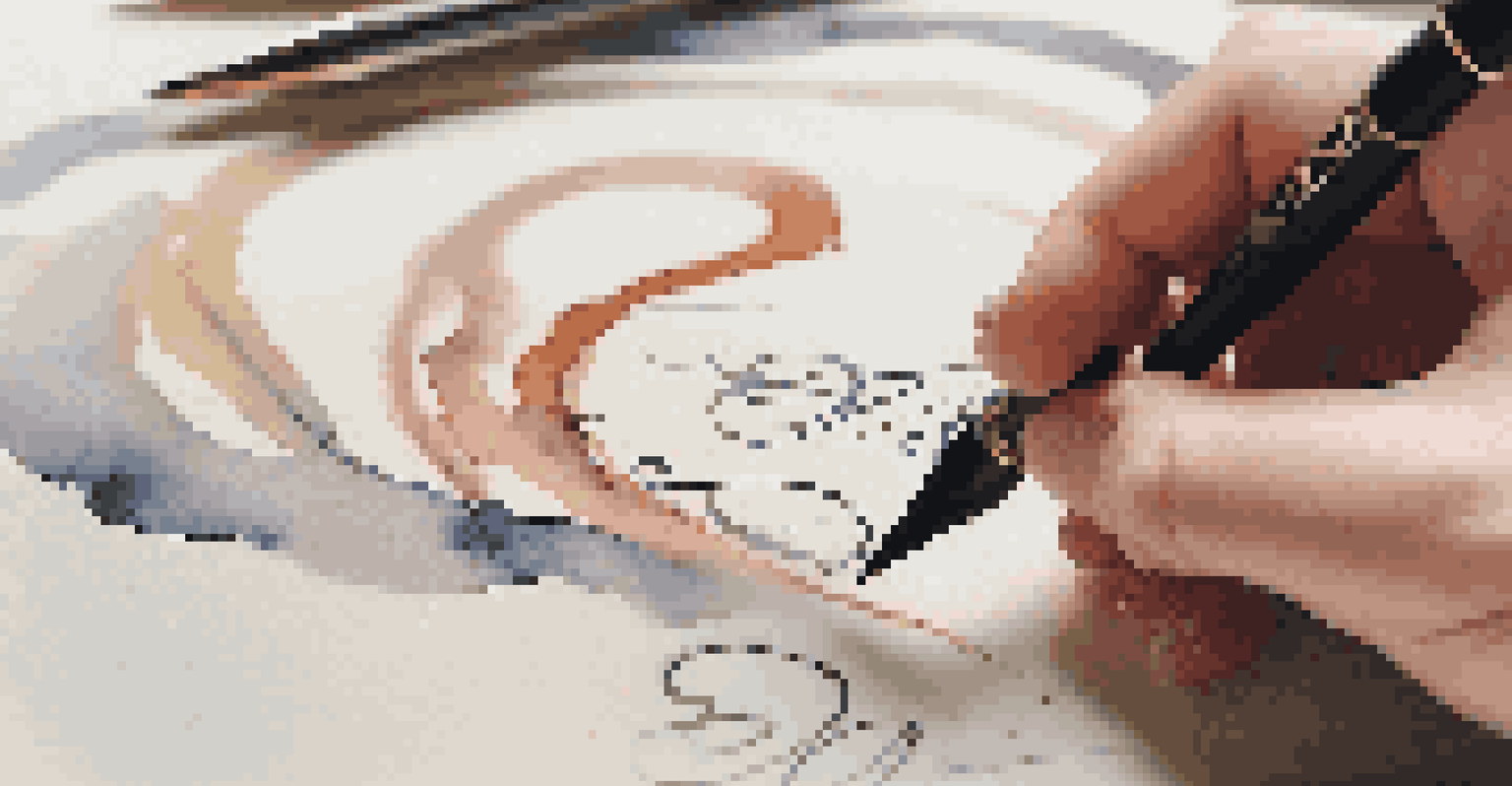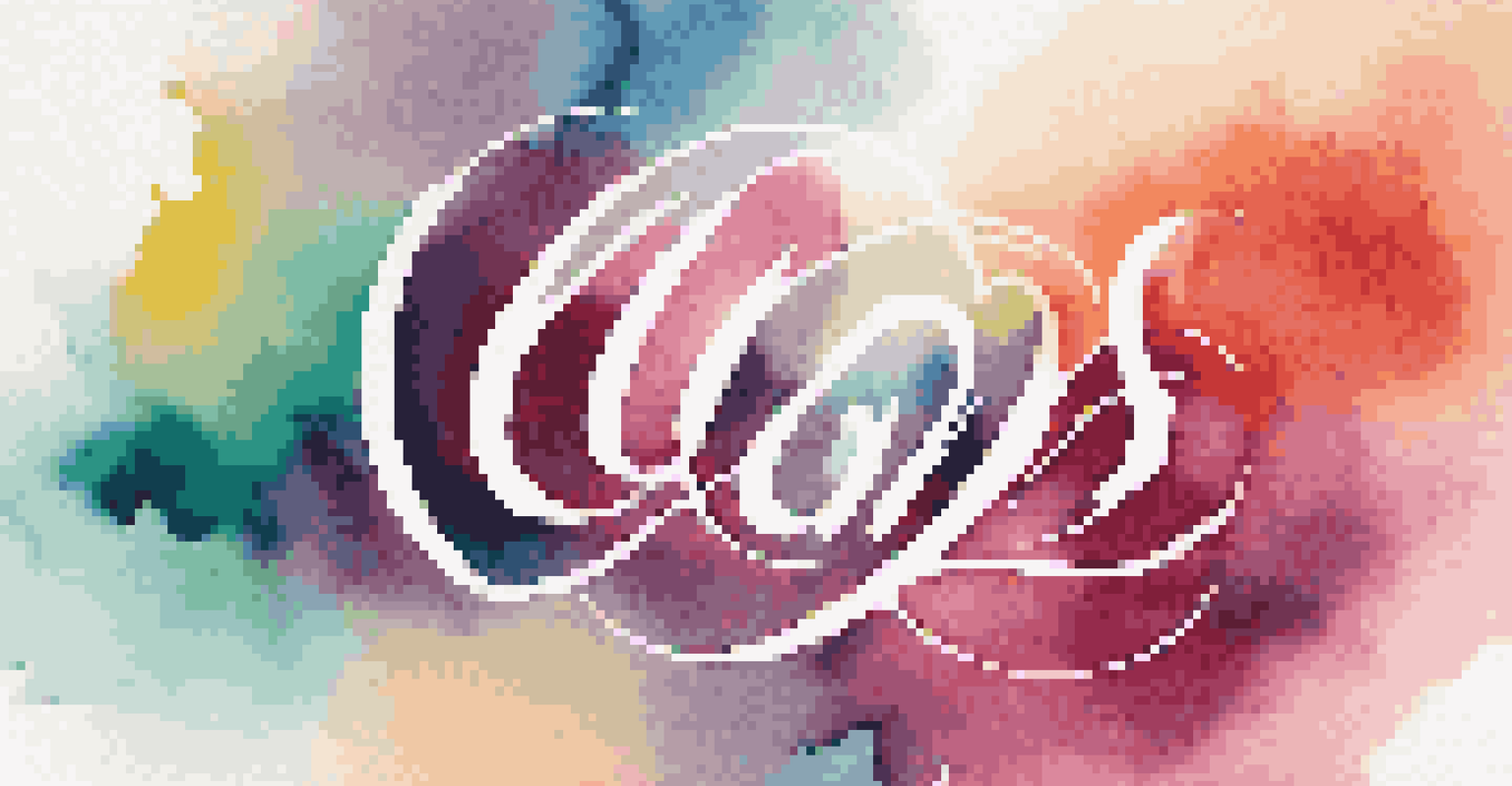The Art of Calligraphy: Combining Tradition with Innovation

Understanding the Roots of Calligraphy and Its Significance
Calligraphy, often referred to as the art of beautiful writing, has roots that stretch back thousands of years. It originated in ancient civilizations, where each stroke was not only a form of communication but also an art form. The significance of calligraphy lies in its ability to convey emotion and meaning through elegant lettering, making it a cherished skill across cultures.
Calligraphy is a form of expression that transcends language and culture.
In various cultures, from Arabic to Chinese, calligraphy has been revered not only for its aesthetics but also for its spiritual significance. For instance, in Islamic culture, calligraphy is seen as a way to express the divine, while in East Asia, it harmonizes with philosophical concepts like balance and simplicity. This deep-rooted history adds layers of meaning to the practice, making it more than just writing.
Understanding these historical contexts enriches our appreciation for calligraphy today. As we explore the modern adaptations of this ancient art form, it’s essential to recognize the traditions that have shaped it. This blend of history and innovation continues to inspire artists, allowing for a dynamic evolution of styles and techniques.
The Tools of the Trade: Essential Calligraphy Supplies
To embark on a calligraphy journey, having the right tools is crucial. Traditional calligraphy often employs specific pens, brushes, and inks that contribute to the unique style of each artist. For instance, a dip pen with a flexible nib allows for a range of strokes, making it a favorite among many calligraphers.

Modern calligraphers have expanded their toolkit to include a variety of new materials. Brush pens, markers, and even digital tools are now commonly used to create stunning lettering. Each tool brings its own flair, allowing artists to experiment and find the best fit for their individual style.
Calligraphy's Rich Cultural Heritage
Calligraphy is a revered art form across cultures, blending aesthetics with spiritual significance and deep historical roots.
Choosing the right tools can be overwhelming, especially for beginners. However, starting with a basic set—such as a dip pen, ink, and some quality paper—can help you get a feel for the art. As you grow more comfortable, you can gradually explore and invest in additional supplies that suit your evolving style.
Traditional Techniques: Mastering the Basics of Calligraphy
Before diving into innovative styles, mastering traditional techniques is essential for any aspiring calligrapher. These foundational skills include understanding letterforms, spacing, and line quality. Practicing these basics helps develop muscle memory, which is critical for consistent and beautiful lettering.
The pen is mightier than the sword; it is more powerful than the sword because it can create and inspire.
One popular traditional style is Copperplate, known for its elegant curves and loops. By practicing the basic strokes of this style, artists can create stunning phrases and quotes. Additionally, focusing on the rhythm and pressure of each stroke allows for greater control and expression in your work.
As you become proficient in these techniques, you’ll gain confidence to experiment with your own unique flair. This mastery of the basics not only enhances your skills but also provides a solid framework for innovation. Traditional techniques serve as a springboard into the creative possibilities that lie ahead.
Innovative Styles: Exploring Modern Calligraphy Trends
In recent years, calligraphy has seen a resurgence in popularity, thanks in part to social media platforms like Instagram and Pinterest. Artists are experimenting with contemporary styles that blend traditional techniques with modern aesthetics. This innovative approach allows calligraphy to remain relevant and appealing to new audiences.
One exciting trend is the use of watercolors in calligraphy, creating vibrant and playful designs. By combining brush lettering with watercolor backgrounds, artists can create stunning visuals that capture attention. This fusion of mediums adds depth and dimension to traditional lettering, pushing the boundaries of the art form.
Essential Tools for Calligraphy
Having the right tools, ranging from traditional pens to modern digital tools, is crucial for both beginners and seasoned calligraphers.
Innovative styles also include digital calligraphy, where artists use tablets and software to create beautiful designs. This not only allows for greater flexibility in editing but also opens up new avenues for sharing and collaborating. Embracing these trends helps keep the art of calligraphy alive and thriving in a digital age.
The Role of Technology in Modern Calligraphy Practices
Technology has had a profound impact on the way we approach calligraphy today. With the rise of digital tools, artists can create stunning designs without the limitations of traditional materials. Programs like Procreate and Adobe Illustrator allow for precision and creativity, enabling artists to explore new styles and techniques.
Moreover, online platforms have made it easier than ever to share and learn from one another. Aspiring calligraphers can access tutorials, join online communities, and participate in challenges that foster growth and creativity. This sense of connection has transformed the calligraphy landscape, bringing together a diverse group of artists.
While technology offers new opportunities, it’s essential to strike a balance between digital and traditional practices. Many artists find joy in combining both methods, creating a harmonious blend of old and new. By embracing technology while honoring tradition, calligraphy continues to evolve and inspire.
Calligraphy in Everyday Life: Applications and Uses
Calligraphy is not just an art form; it has practical applications in our everyday lives. From wedding invitations to personalized gifts, beautifully crafted lettering adds a touch of elegance and thoughtfulness. People are increasingly seeking out calligraphers to create custom pieces that reflect their unique style and personality.
In addition to personal projects, calligraphy is gaining traction in the business world. Companies use custom lettering for branding, signage, and marketing materials, recognizing the power of a handcrafted touch. This trend highlights the growing appreciation for artisanal skills in a digital landscape dominated by automation.
Finding Your Unique Calligraphy Style
Developing a personal calligraphy style involves experimentation and self-discovery, allowing artists to express their individuality.
By incorporating calligraphy into everyday life, we can elevate ordinary moments into something special. Whether it’s a handwritten note or a beautifully designed poster, the art of calligraphy has the power to transform communication into an experience. This delightful intersection of art and practicality ensures that calligraphy remains a cherished skill.
Finding Your Voice: Developing a Personal Calligraphy Style
One of the most rewarding aspects of calligraphy is the journey toward developing your own unique style. As you practice and explore different techniques, you’ll begin to notice what resonates with you. This self-discovery process is essential in finding your voice as an artist, allowing you to express your individuality.
Experimentation is key in this journey. Try mixing various styles, tools, and mediums to see what speaks to you. Take inspiration from other artists but remember to put your own spin on it. This personal touch is what will set your work apart and make it truly yours.

As you refine your style, don’t be afraid to embrace imperfections. Every artist has their quirks, and these unique elements often become the hallmark of their work. By celebrating your individuality, you’ll not only enhance your calligraphy skills but also enjoy the creative process even more.